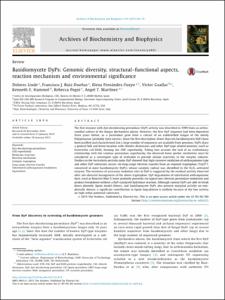Mostra el registre d'ítem simple
Basidiomycete DyPs: Genomic diversity, structural–functional aspects, reaction mechanism and environmental significance
| dc.contributor.author | Linde, Dolores |
| dc.contributor.author | Ruiz-Dueñas, Francisco J. |
| dc.contributor.author | Fernandez-Fueyo, Elena |
| dc.contributor.author | Guallar, Víctor |
| dc.contributor.author | Hammel, Kenneth E. |
| dc.contributor.author | Pogni, Rebecca |
| dc.contributor.author | Martínez, Angel T. |
| dc.contributor.other | Barcelona Supercomputing Center |
| dc.date.accessioned | 2016-03-10T14:25:47Z |
| dc.date.available | 2016-03-10T14:25:47Z |
| dc.date.issued | 2015-05-15 |
| dc.identifier.citation | Linde, Dolores [et al.]. Basidiomycete DyPs: Genomic diversity, structural–functional aspects, reaction mechanism and environmental significance. "Archives of Biochemistry and Biophysics", 15 Maig 2015, vol. 574, p. 66-74. |
| dc.identifier.issn | 0003-9861 |
| dc.identifier.uri | http://hdl.handle.net/2117/84145 |
| dc.description.abstract | The first enzyme with dye-decolorizing peroxidase (DyP) activity was described in 1999 from an arthroconidial culture of the fungus Bjerkandera adusta. However, the first DyP sequence had been deposited three years before, as a peroxidase gene from a culture of an unidentified fungus of the family Polyporaceae (probably Irpex lacteus). Since the first description, fewer than ten basidiomycete DyPs have been purified and characterized, but a large number of sequences are available from genomes. DyPs share a general fold and heme location with chlorite dismutases and other DyP-type related proteins (such as Escherichia coli EfeB), forming the CDE superfamily. Taking into account the lack of an evolutionary relationship with the catalase-peroxidase superfamily, the observed heme pocket similarities must be considered as a convergent type of evolution to provide similar reactivity to the enzyme cofactor. Studies on the Auricularia auricula-judae DyP showed that high-turnover oxidation of anthraquinone type and other DyP substrates occurs via long-range electron transfer from an exposed tryptophan (Trp377, conserved in most basidiomycete DyPs), whose catalytic radical was identified in the H2O2-activated enzyme. The existence of accessory oxidation sites in DyP is suggested by the residual activity observed after site-directed mutagenesis of the above tryptophan. DyP degradation of substituted anthraquinone dyes (such as Reactive Blue 5) most probably proceeds via typical one-electron peroxidase oxidations and product breakdown without a DyP-catalyzed hydrolase reaction. Although various DyPs are able to break down phenolic lignin model dimers, and basidiomycete DyPs also present marginal activity on nonphenolic dimers, a significant contribution to lignin degradation is unlikely because of the low activity on high redox-potential substrates |
| dc.description.sponsorship | This work was supported by the INDOX (KBBE-2013-7-613549; www.indoxproject.eu) European project, the BIO2011-26694 (HIPOP) and CTQ2013-48287 projects of the Spanish Ministry of Economy and Competitiveness (MINECO), and the PRIN 2009-STNWX3 project of the Italian Ministry of Education, University and Research (MIUR). FJR-D thanks a Ramón y Cajal contract of MINECO. The authors thank Verónica Sáez-Jiménez for data on Reactive Blue 5 decolorization by VP and its heme-channel variants. |
| dc.format.extent | 9 p. |
| dc.language.iso | eng |
| dc.publisher | Elsevier |
| dc.rights | Attribution-NonCommercial-NoDerivs 4.0 International License |
| dc.rights.uri | https://creativecommons.org/licenses/by-nc-nd/4.0/ |
| dc.subject | Àrees temàtiques de la UPC::Enginyeria mecànica::Impacte ambiental |
| dc.subject.lcsh | Genetic code |
| dc.subject.other | Dye-decolorizing peroxidases |
| dc.subject.other | CDE superfamily |
| dc.subject.other | Molecular structure |
| dc.subject.other | Reaction mechanism |
| dc.subject.other | Catalytic tryptophan |
| dc.subject.other | Long-range electron transfer |
| dc.subject.other | Substituted anthraquinone breakdown |
| dc.subject.other | Ligninolysis |
| dc.title | Basidiomycete DyPs: Genomic diversity, structural–functional aspects, reaction mechanism and environmental significance |
| dc.type | Article |
| dc.subject.lemac | Genètica bioquímica |
| dc.identifier.doi | 10.1016/j.abb.2015.01.018 |
| dc.description.peerreviewed | Peer Reviewed |
| dc.relation.publisherversion | http://www.sciencedirect.com/science/article/pii/S0003986115000430 |
| dc.rights.access | Open Access |
| dc.description.version | Postprint (published version) |
| dc.relation.projectid | info:eu-repo/grantAgreement/MINECO//CTQ2013-48287-R/ES/DISENYO COMPUTACIONAL RACIONAL DE OXIDOREDUCTASAS PARA APLICACIONES INDUSTRIALES Y TECNOLOGICAS/ |
| dc.relation.projectid | info:eu-repo/grantAgreement/EC/FP7/613549/EU/Optimized oxidoreductases for medium and large scale industrial biotransformations/INDOX |
| local.citation.publicationName | Archives of Biochemistry and Biophysics |
| local.citation.volume | 574 |
| local.citation.startingPage | 66 |
| local.citation.endingPage | 74 |
Fitxers d'aquest items
Aquest ítem apareix a les col·leccions següents
-
Articles de revista [374]


